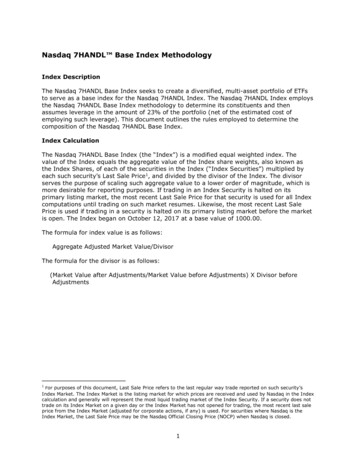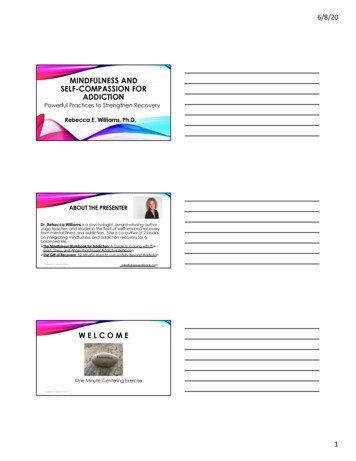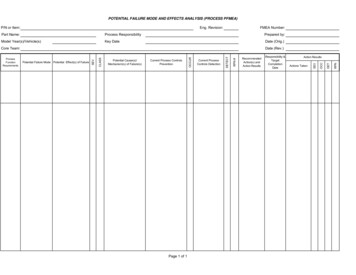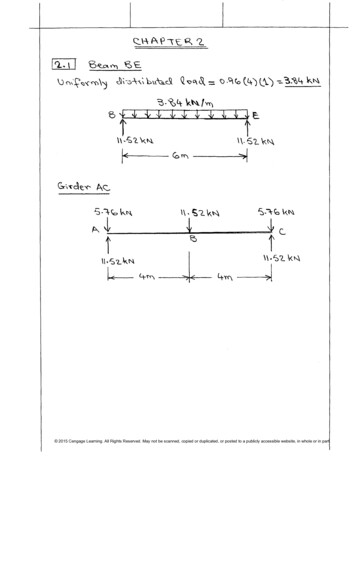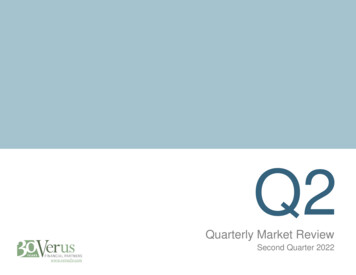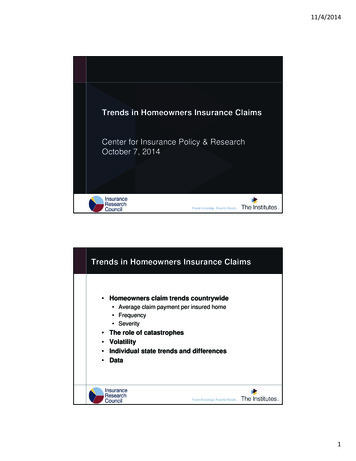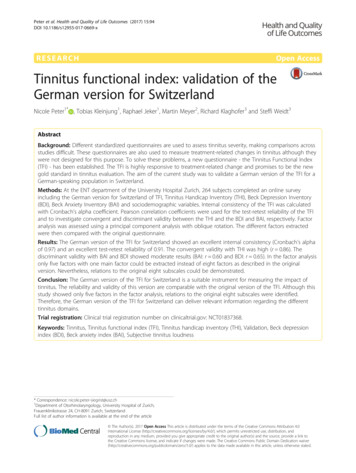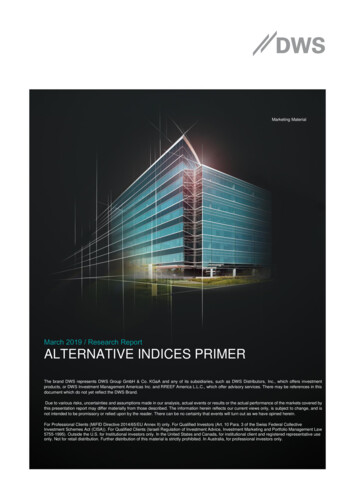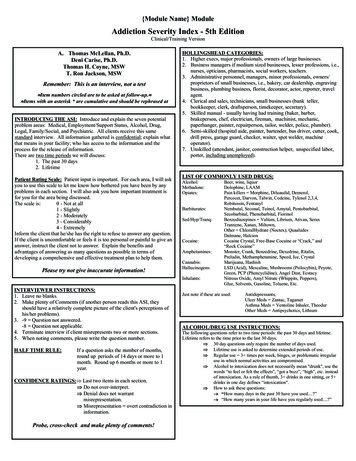
Transcription
{Module Name} ModuleAddiction Severity Index - 5th EditionClinical/Training VersionA. Thomas McLellan, Ph.D.Deni Carise, Ph.D.Thomas H. Coyne, MSWT. Ron Jackson, MSWRemember: This is an interview, not a test Item numbers circled are to be asked at follow-up. Items with an asterisk * are cumulative and should be rephrased atINTRODUCING THE ASI: Introduce and explain the seven potentialproblem areas: Medical, Employment/Support Status, Alcohol, Drug,Legal, Family/Social, and Psychiatric. All clients receive this samestandard interview. All information gathered is confidential; explain whatthat means in your facility; who has access to the information and theprocess for the release of information.There are two time periods we will discuss:1. The past 30 days2. LifetimePatient Rating Scale: Patient input is important. For each area, I will askyou to use this scale to let me know how bothered you have been by anyproblems in each section. I will also ask you how important treatment isfor you for the area being discussed.The scale is:0 - Not at all1 - Slightly2 - Moderately3 - Considerably4 - ExtremelyInform the client that he/she has the right to refuse to answer any question.If the client is uncomfortable or feels it is too personal or painful to give ananswer, instruct the client not to answer. Explain the benefits andadvantages of answering as many questions as possible in terms ofdeveloping a comprehensive and effective treatment plan to help them.Please try not give inaccurate information!HOLLINGSHEAD CATEGORIES:1. Higher execs, major professionals, owners of large businesses.2. Business managers if medium sized businesses, lesser professions, i.e.,nurses, opticians, pharmacists, social workers, teachers.3. Administrative personnel, managers, minor professionals, owners/proprietors of small businesses, i.e., bakery, car dealership, engravingbusiness, plumbing business, florist, decorator, actor, reporter, travelagent.4. Clerical and sales, technicians, small businesses (bank teller,bookkeeper, clerk, draftsperson, timekeeper, secretary).5. Skilled manual - usually having had training (baker, barber,brakeperson, chef, electrician, fireman, machinist, mechanic,paperhanger, painter, repairperson, tailor, welder, police, plumber).6. Semi-skilled (hospital aide, painter, bartender, bus driver, cutter, cook,drill press, garage guard, checker, waiter, spot welder, machineoperator).7. Unskilled (attendant, janitor, construction helper, unspecified labor,porter, including unemployed).LIST OF COMMONLY USED ns:Inhalants:INTERVIEWER INSTRUCTIONS:1. Leave no blanks.2. Make plenty of Comments (if another person reads this ASI, theyshould have a relatively complete picture of the client's perceptions ofhis/her problems).3. -9 Question not answered.-8 Question not applicable.4. Terminate interview if client misrepresents two or more sections.5. When noting comments, please write the question number.HALF TIME RULE:If a question asks the number of months,round up periods of 14 days or more to 1month. Round up 6 months or more to 1year.CONFIDENCE RATINGS: Last two items in each section. Do not over-interpret. Denial does not warrantmisrepresentation. Misrepresentation overt contradiction ininformation.Probe, cross-check and make plenty of comments!Beer, wine, liquorDolophine, LAAMPain killers Morphine, Diluaudid, Demerol,Percocet, Darvon, Talwin, Codeine, Tylenol 2,3,4,Robitussin, FentanylNembutal, Seconal, Tuinol, Amytal, Pentobarbital,Secobarbital, Phenobarbital, FiorinolBenzodiazepines Valium, Librium, Ativan, SeraxTranxene, Xanax, Miltown,Other ChloralHydrate (Noctex), QuaaludesDalmane, HalcionCocaine Crystal, Free-Base Cocaine or “Crack,” and“Rock Cocaine”Monster, Crank, Benzedrine, Dexedrine, Ritalin,Preludin, Methamphetamine, Speed, Ice, CrystalMarijuana, HashishLSD (Acid), Mescaline, Mushrooms (Psilocybin), Peyote,Green, PCP (Phencyclidine), Angel Dust, EcstacyNitrous Oxide, Amyl Nitrate (Whippits, Poppers),Glue, Solvents, Gasoline, Toluene, Etc.Just note if these are used:Antidepressants,Ulcer Meds Zantac, TagametAsthma Meds Ventoline Inhaler, TheodurOther Meds Antipsychotics, LithiumALCOHOL/DRUG USE INSTRUCTIONS:The following questions refer to two time periods: the past 30 days and lifetime.Lifetime refers to the time prior to the last 30 days. 30 day questions only require the number of days used. Lifetime use is asked to determine extended periods of use. Regular use 3 times per week, binges, or problematic irregularuse in which normal activities are compromised. Alcohol to intoxication does not necessarily mean "drunk", use thewords “to feel or felt the effects", “got a buzz”, “high”, etc. insteadof intoxication. As a rule of thumb, 3 drinks in one sitting, or 5 drinks in one day defines “intoxication". How to ask these questions: “How many days in the past 30 have you used.?” “How many years in your life have you regularly used.?”
{Module Name} ModuleAddiction Severity Index - 5th EditionClinical/Training VersionAgency Name:Site Name:ID #:Date: / /GENERAL INFORMATIONG1.ID NumberGENERAL INFORMATION COMMENTSG4.Date of Admission/ /(Include the question number with your notes)mm/dd/yyyyG5.Date of Interview/ /mm/dd/yyyyG6.Time Begun:Use 24 hr clock; code hours:minutesG7.:Time EndedHRSUse 24 hr clock; code hours:minutesClass1 - IntakeG9.Contact Code1 - In personG10.Gender1 - MaleG99.Treatment Episode NumberG11.Interviewer Code NumberG12.Special1 - Patient terminated2 - Patient refused3 - Patient unable to respondG15.G16.MINSG8.G14.2 - Follow-up2 - Telephone (Intake ASI must be in person)2 - FemaleHow long have you lived at your currentaddress?/YRSMOSIs this residence owned by you or your family?0 - No1 - YesDate of birth/ /mm/dd/yyyyG17G18.G19.Of what race do you consider yourself?1 - White (not Hisp)5 - Asian/Pacific2 - Black (not Hisp)6 - Hispanic-Mexican3 - American Indian7 - Hispanic-Puerto Rican4 - Alaskan Native8 - Hispanic-Cuban9 - UnknownDo you have a religious preference?1 - Protestant4 - Islamic2 - Catholic5 - Other3 - Jewish6 - NoneHave you been in a controlled environment inthe past 30 days?1 - No4 - Medical tx2 - Jail/prison5 - Psychiatric tx3 - Alcohol or drug tx6 - OtherHow many days?If G19 is No, code -8.Refers to total number of days detained in the past 30 days.A place, theoretically, without access to drugs/alcohol.G20.
MEDICAL STATUSM1.* How many times in your life have you beenhospitalized for medical problems?Include O.D.’s and D.T.’s. Exclude detox, alcohol/drug, psychiatric treatmentand childbirth (if no complications). Enter the number of overnighthospitalizations for medical problems.M2.How long ago was your last hospitalization fora physical problem?/YRSMOSMEDICAL COMMENTS(Include the question number with your notes)If no hospitalizations in Question M1, then code -8 / -8.M3.Do you have any chronic medical problems whichcontinue to interfere with your life?0 - No1 - YesIf Yes, specify in comments.A chronic medical condition is a serious physical condition that requires regularcare (i.e., medication, dietary restriction) preventing full advantage of theirabilities.M4.Are you taking any prescribed medication on aregular basis for a physical problem?0 - No1 - YesIf Yes, specify in comments.Medication prescribed by a MD for medical conditions; not psychiatricmedicines. Include medicines prescribed whether or not the patient is currentlytaking them. The intent is to verify chronic medical problems.M5.Do you receive a pension for a physical disability?0 - No1 - YesIf Yes, specify in comments.Include Workers’ compensation, exclude psychiatric disability.M6.How many days have you experienced medicalproblems in the past 30 days?For Questions M7 & M8, ask patient to use the Patient Rating ScaleRestrict response to problem days in Question M6.M8. How important to you now is treatment for these medicalproblems?Include flu, colds, etc. Include serious ailments related to drugs/alcohol, whichwould continue even if the patient were abstinent (e.g., cirrhosis of liver,abscesses from needles, etc.).M7. How troubled or bothered have you been by thesemedical problems in the past 30 days?If client is currently receiving medical treatment, refer to the need foradditional medical treatment by the patient.INTERVIEWER SEVERITY RATINGM9. How would you rate the patient’s need for medicaltreatment?Refers to the patient’s need for additional medical treatment.CONFIDENCE RATINGSIs the above information significantly distorted by:M10. Patient’s misrepresentation?0 - No1 - YesM11. Patient’s inability to understand?0 - No1 - Yes
EMPLOYMENT/SUPPORT STATUSE1.E2.**E3.Education completed/GED 12 years, note in comments.Include formal education only.YRSTraining or technical education completedMOSFormal, organized training only. For military training, onlyinclude training that can be used in civilian life (i.e., electronics,computers).MOSEmployable, transferable skill acquired through training.Do you have a valid driver’s license?0 - No1 - YesDo you have an automobile available for use?0 - No1 - YesIf answer to E4 is No, then E5 must be No.Does not require ownership, only requires availability on a regular basis.How long was your longest full-time job?Full-time 35 hours weekly; does not necessarily meanmost recent job.E7.*/YRSMOSDoes someone contribute to your support in any way?0 - No1 - YesIs patient receiving any regular support (i.e., cash, food, housing) from family/friend. Include spouse’s contribution; exclude support by an institution.Does this support constitute the majority of yoursupport?0 - No1 - YesIf E8 is No, then E9 is -8.E10. Usual employment pattern, past 3 years?1 - Full time (35 hours)2 - Part time (regular hours)3 - Part time (irregular hours)4 - StudentUsual (or last) occupationUse Hollingshead Categories Reference SheetE9.SpecifyE8.Valid license; not suspended/revoked.E6.If Yes, specify:E5.(Include the question number with your notes)Do you have a profession, trade, or skill?0 - No1 - YesE4.EMPLOYMENT/SUPPORT COMMENTS5 - Military service6 - Retired/disability7 - Unemployed8 - In controlled environmentAnswer should represent the majority of the last 3 years, not just the mostrecent selection. If there are equal times for more than one category, selectthat which best represents the current situation.E11. How many days were you paid for working in thepast 30 days?Include “under-the-table” work, paid sick days and vacation.
EMPLOYMENT/SUPPORT STATUS (cont)For questions E12-E17:How much money did you receive from the following sources inthe past 30 days?E12. EmploymentNet or “take home” pay, include any “under thetable” money. ,E13. Unemployment compensation ,E14. Welfare ,Include food stamps, transportation moneyprovided by an agency to go to and from treatment.E15. Pension, benefits or social securityInclude disability, pensions, retirement, veteran’sbenefits, SSI & workers’ compensation.E16. Mate, family or friendsMoney for personal expenses (i.e., clothing);include unreliable sources of income.Record cash payments only, include windfalls(unexpected), money from loans, legal gambling,inheritance, tax returns, etc.E17. IllegalCash obtained from drug dealing, stealing, fencingstolen goods, illegal gambling, prostitution, etc.Do not attempt to convert drugs exchanged to adollar value. ,EMPLOYMENT/SUPPORT COMMENTS(Include the question number with your notes) , ,E18. How many people depend on you for the majorityof their food, shelter, etc.?Must be regularly depending on patient; do include alimony/child support, do notinclude the patient or self-supporting spouse, etc.E19. How many days have you experienced employmentproblems in the past 30?Include inability to find work, if they are actively looking for work, or problemswith present job in which that job is jeopardized.For Questions E20 & E21, ask patient to use the Patient Rating ScaleE20. How troubled or bothered have you been by theseemployment problems in the past 30 days?If the patient has been incarcerated or detained during the past30 days, they cannot have employment problems. In that case,code -8.E21. How important to you now is counseling for theseemployment problems?Stress help in finding or preparing a job, not giving them a job.INTERVIEWER SEVERITY RATINGE22. How would you rate the patient’s need foremployment counseling?CONFIDENCE RATINGSIs the above information significantly distorted by:E23.Client’s misrepresentation?0 - No1 - YesE24.Client’s inability to understand?0 - No1 - Yes
ALCOHOL/DRUGSRoute of Administration Types:1 - Oral2 - Nasal3 - Smoking4 - Non-IV injection5 - IVNote the usual or most recent route. For more than one route, choose the mostsevere. The routes are listed from least severe to most severe.D1.Alcohol (any use at all)A.Past 30DaysB.Lifetime(Years)C.Route ofAdminALCOHOL/DRUGS COMMENTS(Include the question number with your notes)D2.Alcohol (to intoxication)D3.HeroinD4.MethadoneD5.Other Opiates/AnalgesicsD6.BarbituratesD7.Other etaminesD10. CannabisD11. HallucinogensD12. InhalantsD13. More than one substance per dayIncluding alcoholD14. According to the interviewer, which substance is/arethe major problem?Interviewer should determine the major drug or drugs of abuse.Code the number next to the drug in questions D1-D12, or:00 no problem15 alcohol & one or more drugs16 more than one drugs but no alcohol.Ask patient when not clear.D15.D16.How long was your last period of voluntaryabstinence from this major substance?MOSLast attempt of at least one month, not necessarily the longest. Periods ofhospitalization/incarceration do not count. Periods of antabuse, methadone,or naltrexone use during abstinence do count.00 never abstinentHow many months ago did this abstinence end?If D15 0, then D16 -8, 00 Still abstinentMOS
ALCOHOL/DRUGS (cont)D17.* How many times have you had Alcohol D.T.’s?D18.*Delirium Tremems (DTs): Occur 24-48 hours after last drink,or significant decrease in alcohol intake, shaking, severedisorientation, fever, hallucinations, they usually requiremedical attention.How many times have you overdosed on drugs?ALCOHOL/DRUG COMMENTS(Include the question number with your notes)Overdoses (OD): Require requires intervention by someoneto recover, not simply sleeping it off, include suicide attemptsby OD.How many times in your life have you been treated for:D19.* Alcohol abuse?D20.* Drug abuse?Include detoxification, halfway houses, in/outpatient counseling,and AA or NA (if 3 meetings within one month period).D21.*How many of these were detox only?Alcohol?If D19 0, then D21 -8D22.* Drugs?If D20 0, then D22 -8How much money would you say you spent during the past 30days on:D23.Alcohol? ,D24.Drugs? ,Only count actual money spent. What is the financial burden caused bydrugs/alcohol?D25. How many days have you been treated in anoutpatient setting for alcohol or drugs in the past30 days?Include AA/NAD27.How many days in the past 30 have you experienced:D26.Alcohol problems?Drug problems?Include craving, withdrawal symptoms, disturbing effects of use, or wanting tostop and being unable to.For Questions D28 - D31, ask patient to use the Patient Rating ScaleHow troubled or bothered have you been in the past 30 days bythese:D28.Alcohol problemsD29.Drug problemsHow important to you now is treatment for these:D30. Alcohol problemsD31. Drug problemsINTERVIEWER SEVERITY RATINGHow would you rate the patient’s need for treatment for:D32.Alcohol problemsD33.Drug problemsCONFIDENCE RATINGSIs the above information significantly distorted by:D34.Client’s misrepresentation?0 - No1 - YesD35.Client’s inability to understand?0 - No1 - Yes
LEGAL STATUSWas this admission prompted or suggested by thecriminal justice system?0 - No1 - YesL1.Judge, probation/parole officer, etc.L2.LEGAL COMMENTS(Include the question number with your notes)Are you on probation or parole?0 - No1 - YesNote duration and level in comments.How many times in your life have you been arrested andcharged with the ation ViolationsL5.*Drug ChargesL6.*ForgeryL7.*Weapons OffenseL8.*Burglary/Larceny/Breaking & EnteringL9.*RobberyL10. * AssaultL11. * ArsonL12. * RapeL13. * Homicide/ManslaughterL14. * ProstitutionL15. * Contempt of CourtL16. * Other:Include total number of counts, not just convictions.Do not include juvenile (pre-age 18) crimes, unless they were tried as an adult.Include formal charges only.L17.* How many of these charges resulted in convictions?If L3-16 00, then Question L17 -8.Do not include misdemeanor offenses from questions L18-20 below.Convictions include fines, probation, incarcerations, suspended sentences,guilty please, and plea bargaining.How many times in your life have you been charged with thefollowing:L18. * Disorderly conduct, vagrancy, public intoxicationL19. * Driving while intoxicatedL20. * Major driving violationsL21. * How many months were you incarcerated in yourlife?Moving violations: speeding, reckless driving, no license, etc.If incarcerated 2 weeks or more, round this up to 1 month.List total number of months incarcerated.L22.How long was your last incarceration?Of 2 weeks or more. Code -8 if never incarcerated.L23.What was it for?MOSMOSUse codes 03–16, 18–20If multiple charges, code most severe.Code -8 if neverincarcerated.L24.Are you presently awaiting charges, trial, or sentence?0 - No1 - YesL25.What for?Refers to Question L24. Use the number of the type of crimecommitted: 03-16 and 18-20. If multiple charges, code most severe.
LEGAL STATUS (cont)L26.How many days in the past 30 were you detained orincarcerated?Include being arrested and released on the same day.L27.How many days in the past 30 have you engaged inillegal activities for profit?For Questions L28 & L29, ask patient to use the Patient Rating ScaleHow serious do you feel your present legal problemsare?Exclude civil problems.L29.How important to you now is counseling or referralfor these legal problems?Patient is rating a need for additional referral to legal counsel fordefense against criminal charges.How would you rate the patient’s need for legalservices or counseling?INTERVIEWER SEVERITY RATINGL30.Exclude simple drug possession. Include drug dealing,prostitution, selling stolen goods, etc. May be cross-checkedwith E17 under Employment section.L28.LEGAL COMMENTS(Include the question number with your notes)CONFIDENCE RATINGSIs the above information significantly distorted by:L31.Client’s misrepresentation?0 - No1 - YesL32.Client’s inability to understand?0 - No1 - Yes
FAMILY HISTORYHave any of your blood-related relatives had what you would call a significant drinking, drug use or psychiatric problem?Specifically, was there a problem that did or should have led to treatment?0 - Clearly NO for all relatives in the category1 - Clearly YES for any relative within category-9 - Uncertain or don’t know-8 - Never was a relativeIn cases where there is more than one person for a category, record the occurrence of problems for any in that group.Accept the patient’s judgment on these questions.Mother’s herH4.H5.Father’s .AuntUncleH10.UncleFAMILY HISTORY COMMENTS(Include the question number with your notes)
FAMILY/SOCIAL RELATIONSHIPSF1.Marital Status1 - Married2 - Remarried3 - Widowed4 - Separated5 - Divorced6 - Never marriedCommon-law marriage 1. Specify in comments.F2.How long have you been in this marital status?Refers to F1. If never married, then since age 18.F3./YRSAre you satisfied with this situation?0 - No1 - Indifferent2 - YesMOSSatisfied client generally liking the situation.Refers to F1 and F2.F4.*Usual living arrangements (past 3 years)1 - With sexual partner & children2 - With sexual partner alone3 - With children alone4 - With parents5 - With family6 - With friends7 - Alone8 - Controlled environment9 - No stable arrangementChoose arrangements most representative of the past 3 years. If there is aneven split in time between these arrangements, choose the most recentarrangement.F5.How long have you lived in these arrangements?/If with parents or family, since age 18.Code years and months living in arrangements from F4.F6.FAMILY/SOCIAL COMMENTS(Include the question number with your notes)YRSMOSAre you satisfied with these arrangements?0 - No1 - Indifferent2 - YesDo you live with anyone who:F7.Has a current alcohol problem?0 - No1 - YesF8.Uses non-prescribed drugs?0 - No1 - YesOr abuses prescribed drugsF9.With whom do you spend most of your free time?1 - Family2 - Friends3 - AloneIf a girlfriend/boyfriend is considered as family by patient, then they must referto them as family throughout this section, not a friend.F10.Are you satisfied with spending your free time thisway?0 - No1 - Indifferent2 - YesA satisfied response must indicate that the person generally likes the situation.Refers to F9.F11.How many close friends do you have?Stress that you mean close.Exclude family members.These are “reciprocal” relationships or mutually supportiverelationships.Would you say you have had a close reciprocal relationshipwith any of the following .Sexual Partner/SpouseF16.ChildrenF17.Friends0 - Clearly NO for all in class1 - Clearly YES for any in class-9 - Uncertain or “I don’t know”-8 - Never was a relativeBy reciprocal, you mean “that you would do anything you could to help themout and vice versa.”
FAMILY/SOCIAL RELATIONSHIPS (cont)Have you had significant periods in which you have experiencedserious problems getting along with:0 - No1 - YesPast 30 Days In Your xual Partner/SpouseF22.ChildrenF23.Other significant familySpecify:F24.Close FriendsF25.NeighborsF26.Co-Workers“Serious problems” mean those that endangered the relationship.A “problem” requires contact of some sort, either by telephone or in person.If no contact, code -8.F27.Has anyone ever abused you?0 - No1 - YesEmotionally?In Your LifePhysically?Caused you physical harmF29.Past 30 DaysMake you feel bad through harsh wordsF28.FAMILY/SOCIAL COMMENTS(Include the question number with your notes)Sexually?Force sexual advances/actsHow many days in the past 30 have you had serious conflicts:F30.With your family?F31.With other people? (excluding family)For Questions F32 - F35, ask patient to use the Patient Rating ScaleHow troubled or bothered have you been in the past 30 days by:F32.Family problemsF33.Social problemsHow important to you now is treatment or counseling for these:F34.Family problemsPatient is rating his/her need for counseling for family problems,not whether they would be willing to attend.F35.Social problemsInclude patient’s need to seek treatment for such social problemsas loneliness, inability to socialize, and dissatisfaction with friends.Patient rating should refer to dissatisfaction, conflicts, or otherserious problems.INTERVIEWER SEVERITY RATINGF36.How would you rate the patient’s need for family and/or social counseling?CONFIDENCE RATINGSIs the above information significantly distorted by:F37.Client’s misrepresentation?0 - No1 - YesF38.Client’s inability to understand?0 - No1 - Yes
PSYCHIATRIC STATUSHow many times have you been treated for any psychological oremotional problems:P1.*In a hospital or inpatient setting?P2.*Outpatient/private patient?Do not include substance abuse, employment, or family counseling. Treatmentepisode a series of more or less continuous visits or treatment days, not thenumber of visits or treatment days.Enter diagnosis in comments if known.P3.P4.P5.Do you receive a pension for a psychiatric disability?0 - No1 - YesHave you had a significant period of time (that was not a directresult of drug/alcohol use) in which you have:0 - No1 - YesPast 30 Days In Your LifeExperienced serious depressionSadness, hopelessness, loss of interest,difficulty with daily functioningExperienced hallucinationsSaw things/heard voices that others didn’tsee/hearP7.Experienced trouble understanding,concentrating or rememberingP8.Experienced trouble controlling violentbehavior including episodes or rage orviolenceP11. Been prescribed medication for anypsychological or emotional problemsPrescribed for the patient by a physician. Record“Yes” if a medication was prescribed even if thepatient is not taking it.P10. Attempted suicideInclude actual suicidal gestures or attempts.Patient can be under the influence of alcohol /drugs.Experienced serious thoughts of suicidePatient seriously considered a plan for taking his/her life.Patient can be under the influence of alcohol/drugs.Patient can be under the influence of alcohol/drugs.P9.(Include the question number with your notes)Experienced serious anxiety or tensionUptight, unreasonably worried, inability tofeel relaxedP6.PSYCHIATRIC STATUS COMMENTSP12. How many days in the past 30 have you experiencedthese psychological or emotional problems?Refers to problems noted in Questions P4-P10.For Questions P13 & P14, ask the patient to use the Patient Rating ScaleP13. How much have you been troubled or bothered bythese psychological or emotional problems in thepast 30 days?Patient should be rating the problem days from Question P12.P14. How important to you now is treatment for thesepsychological problems?
PSYCHIATRIC STATUS (cont)The following items are to be completed by the interviewer:At the time of the interview, the patient was:0 - NoPSYCHIATRIC STATUS COMMENTS1 - YesP15. Obviously depressed/withdrawnP16. Obviously hostileP17. Obviously anxious/nervousP18. Having trouble with reality testing, thought disorders,paranoid thinkingP19. Having trouble comprehending, concentrating,rememberingP20. Having suicidal thoughts(Include the question number with your notes)INTERVIEWER SEVERITY RATINGP21. How would you rate the patient’s need for psychiatric/psychological treatment?CONFIDENCE RATINGSIs the above information significantly distorted by:P22. Client’s misrepresentation?0 - No1 - YesP23. Client’s inability to understand?0 - No1 - Yes
SEVERITY SOCPSYCH0123456789
A. Thomas McLellan, Ph.D. Deni Carise, Ph.D. Thomas H. Coyne, MSW T. Ron Jackson, MSW Remember: This is an interview, not a test Item numbers circled are to be asked at follow-up. Items with an asterisk * are cumulative and should be rephrased at INTRODUCING THE ASI: Introduce and explain the sev
